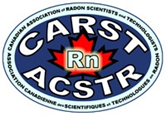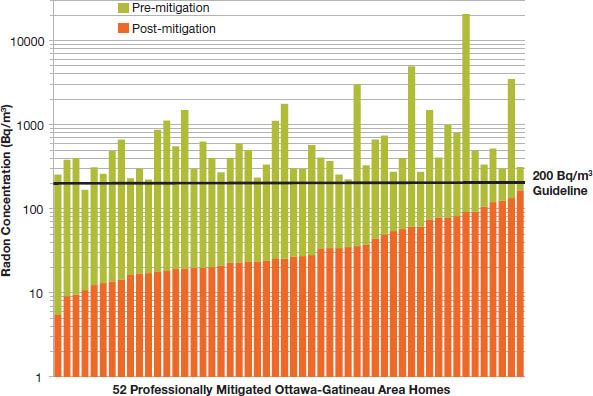 Canadian Association of Radon Scientists and Technologists Helping Canadians Reduce Radon Risk |

Four steps to Reduce your Radon Exposure / Quatre étapes pour réduire votre exposition au radon |
Radon poses a significant health threat as the leading cause of lung cancer in non-smokers. No area is radon free - it is naturally occurring radioactive gas that is invisible to the human senses. The only way to know the radon level in a building (home, school or workplace) is to test. We recommend testing for radon in the first heating season in your home and retesting every five years, or sooner if you complete major renovations. There are multiple ways you can test. You can purchase a do-it-yourself kit or contact a C-NRPP Measurement certified professional to do it for you. If you do the test yourself, make sure you read and follow the instructions. | Le RADON est présent partout – La totalité des habitations et des bâtiments devrait subir une mesure du radon. Le radon est un gaz invisible, inodore et sans goût. La seule façon de connaître la concentration du radon dans un bâtiment (à la maison, à l’école ou au travail), c'est d’effectuer une mesure. Toutes les maisons, les nouvelles comme les anciennes, doivent subir une mesure du radon. Pour les constructions neuves, nous vous recommandons d’effectuer une mesure au cours de la première saison avec chauffage dans la maison. |
Purchase a DIY radon detector or contact one of our members to help. | Communiquez avec l’un de nos membres pour obtenir de l’aide. |
Long-Term Testing CARST recommends following Health Canada recommendations and testing during the heating season with a minimum 91 day test. A long-term test provides a year-long average of your radon exposure. Radon levels can fluctuate on a day to day and season to season basis. A long-term radon test provides an average level. This testing also provides information on how your home’s radon levels put you at risk for lung cancer, since prolonged exposure to radon increases risk of lung cancer. If you do the test yourself, make sure you read and follow the instructions. Mesure à long terme Une mesure à long terme s’étale sur plus de 91 jours. Elle peut durer de 91 jours à un an. Une mesure à long terme permet d’effectuer une moyenne annuelle de l’exposition au radon. Le niveau de radon peut varier d’un jour à l’autre et d’une saison à l’autre. Une mesure à long terme du radon permet d’obtenir une moyenne du niveau de concentration. Cette mesure permet également d’évaluer de quelle façon le niveau de radon dans votre maison est risqué pour développer un cancer du poumon et dans quelle mesure une exposition prolongée accroît le risque de cancer du poumon. Si vous effectuez vous-même la mesure, assurez-vous de bien lire les directives pour comprendre la durée adéquate du test de mesure que vous avez acheté. Short-Term Testing A short-term radon measurement test must be a minimum duration of 48 hours up to 91 days. These tests may provide relatively quick results and can act as a screening tool. Health Canada recommends that a long-term test be conducted before making a decision to mitigate. If you have installed a mitigation system into your home, a certified mitigator should do a short-term radon test to ensure the system is effective in lowering the radon levels in the home. The test duration should last for a minimum of 48 hours and it should be started at least 24 hours after the fan for the system has been turned on. The homeowner should then follow up with a long-term test during the next winter season after the mitigation system was installed. Mesure à court terme Une mesure à court terme du radon fournit des résultats rapidement. Cette mesure doit durer au moins 48 heures, jusqu’à 91 jours. La mesure à court terme vise à donner des résultats plus rapidement qu’une mesure à long terme, car ces données peuvent s’avérer utiles dans de nombreuses situations. Santé Canada recommande qu’une prise de décision relative à une atténuation s’appuie sur les résultats d’une mesure à long terme. |
To get accurate results, the radon measurement device must stay undisturbed in one location for the duration of the test. Ensure that you keep the return packaging for the device to return to the lab it was purchased from. Mark the date to return to the lab for analysis, or call your professional to come back and pick it up at the end of the testing period. | L’appareil de mesure du radon doit rester à son emplacement pour toute la durée de la mesure, puis être retourné au laboratoire. Conservez le carton de retour fourni avec l’appareil pour pouvoir le retourner au laboratoire d’où vous l’avez acheté. Inscrivez la date avant de le retourner au laboratoire. Vous pouvez aussi communiquer avec votre professionnel du radon pour qu’il revienne chez vous à la fin de la mesure et qu’il rapporte l’appareil. |
The laboratory will report your radon test results after analyzing the device. Health Canada recommends that all Canadian buildings aim to maintain radon levels below 200 Bq/m3 to minimize health risks. While further reduction is possible, it's ultimately the homeowner's choice. If long-term measurements exceed 200 Bq/m3 , Health Canada offers guidelines for mitigation timelines.
Note: Average outdoor radon concentration=15 Bq/m3 | Le laboratoire vous transmettra les résultats de la mesure après l’analyse de l’appareil. Santé Canada a établi une ligne directrice à 200 Bq/m3 et souhaiterait que les bâtiments canadiens ne dépassent pas cette limite. Le risque pour la santé est plus faible si les niveaux sont inférieurs à 200 Bq/m3. Alors qu’il est possible de réduire davantage le niveau de radon et le risque pour la santé, Santé Canada considère qu’à un niveau de 200 Bq/m3, le choix de réduire davantage le niveau de radon revient au propriétaire. Si les résultats de la mesure à long terme sont supérieurs à 200 Bq/m3, Santé Canada a donné quelques suggestions quant à des échéanciers à suivre pour l’atténuation. |
If you have tested your home and discovered it requires radon mitigation, hire a C-NRPP Mitigation Professional with proper training and hands-on experience to reduce the radon levels. Radon Mitigation can include measures which will include sealing, removing or ventilating. Sealing the building foundation will attempt to prevent radon entry. Ventilating the building air will provide dilution of the inside air reducing radon concentrations. Active Soil Depressurization (ASD) - a radon mitigation system which removes the radon from below a building and provides a pathway for it to exit outside. ASD is the most effective method of reducing radon levels in a home.
| Si vous avez testé votre maison et découvert qu’une atténuation s’avère nécessaire, faites affaire avec un professionnel en atténuation du PNCR-C qui possède la formation adéquate et de l’expérience en atténuation du radon. L’atténuation du radon peut présenter des mesures qui comprennent le colmatage, l’élimination ou la ventilation. Le colmatage de la fondation du bâtiment vise à empêcher l’infiltration du radon dans le bâtiment. La ventilation de l’air dans le bâtiment fournira une dilution de l’air intérieur, réduisant ainsi la concentration du radon. La dépressurisation active du sol est un système de réduction du radon qui permet d’éliminer le radon qui provient d’en dessous du bâtiment, et de lui fournir une sortie vers l’extérieur. Ce type de dépressurisation constitue la méthode d’atténuation du radon la plus efficace dans une maison. |
In Health Canada’s Active Soil Depressurization (ASD) Field Study of 52 homes, they found a 90.7% reduction in radon with an ASD system. |




